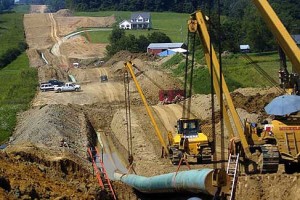PennEast Construction Plan
According to the final draft of PennEast’s Resource Report 01 (2014), the typical pipeline construction process consists of the following steps:
- Survey/demarcate the route and approved workspace.
- Centerline survey of existing or proposed pipelines.
- Clearing – remove vegetation from construction work area (CWA); installation of erosion and sediment controls.
- Additional protection of adjacent pipeline, as necessary; grading to establish safe workspace; completion of installation of erosion and sediment controls.
- Trenching – pipeline trench excavation to design depths.
- Stringing – placement of pipe joints along the trench line.
- Bending – bending pipe joints, as needed, for route and terrain.
- Weld pipe.
- Pipe integrity – visual inspection, non-destructive examination (NDE) of welds.
- Weld coating – corrosion protection and waterproofing.
- Pipe placement – pipe placed in trench, tied to previously laid sections, backfilled.
- Hydrostatic testing – confirmation of pipeline segments.
- In-line tool inspection of new pipeline segments.
- Tie-in to existing pipeline, purge, pack new section with gas.
- Grade restore of CWA to previous contours.
- Final clean-up, restoration, and seeding.

